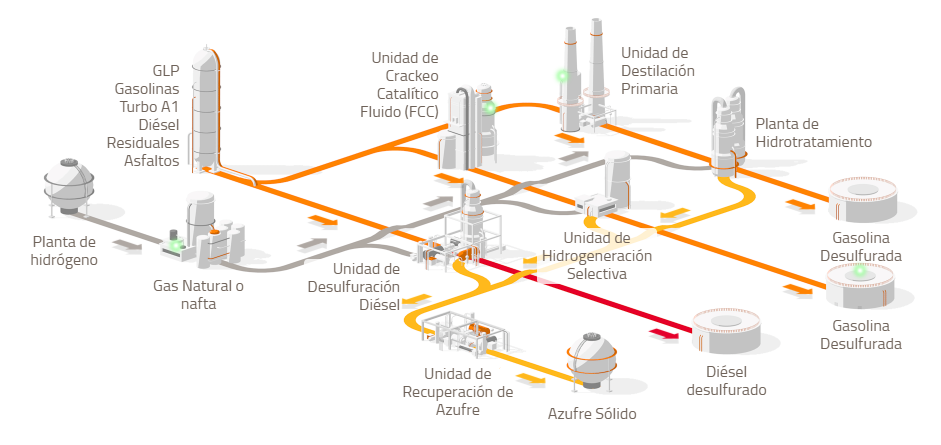La Pampilla’s infrastructure represents approximately 50% of the national refining capacity, and all the fuels we produce here are already low in sulfur.
2016, the beginning of a new stage
In August 2016, the first stage of this important project was completed. With the commissioning of the new units, all the diesel produced at La Pampilla is low in sulfur.
2018, the culmination of the project
In September 2018, the new gasoline plants with low sulfur content were brought online. All the gasoline we produce contains less than 50 parts per million of sulfur.
Higher quality and more environmentally friendly products
All our Repsol Service Stations will dispense Regular and Premium gasohols starting May 1. Both gasohols will feature Neotech, an exclusive formula developed at our Repsol Technology Center in Spain, which guarantees greater efficiency and lower consumption for the engine. Thus, our Regular Gasohol will have a minimum of 93.5 octane, and our Premium Gasohol will have a minimum of 97.5 octane.
The commercialization of these new low-sulfur gasohols will bring major benefits to the health of all Peruvians and to the country’s air quality.
How we remove sulfur from our gasoline and diesel

The extracted sulfur is recovered in solid form in the new plants to be used in agriculture or industry. In this way, we make full use of all the product we process.
Refinery Installations
Primary Distillation Unit I/II and Vacuum Distillation I
Primary distillation (CDU) is the first stage of crude oil processing and consists of a physical separation of the hydrocarbons present in the oil based on their boiling points.
Vacuum distillation is a stage in which the residue from the CDU is fractionated at pressures lower than atmospheric pressure.
Vacuum Distillation Unit I/II
Its objective is to increase the production of gas oils to provide more feedstock for the Fluid Catalytic Cracking Unit (FCCU), export the surplus, and increase the production of middle distillates to reduce their import.
Visbreaking Unit
Its purpose is to reduce the viscosity of residuals, allowing savings on imported diluents for the preparation of industrial fuels.
Fluid Catalytic Cracking Unit (FCC)
In 2022, the FCC expansion project was carried out, doubling its original design capacity. This unit is very important because it converts, through the use of a fluidized bed catalyst, low-value feedstocks into valuable products such as diesel, high-octane gasoline, and LPG.
Diesel Desulfurization Unit
This unit reduces the sulfur content in diesel (to 50 ppm) through hydrogenation using specific catalysts.
The diesel desulfurization unit processes diesel, LVGO, GVB, LVBGO, LCO, kerosene, and naphtha.
Sulfur Recovery Unit
Recovers up to 99.9% of the sulfur contained in the acid gas streams from the amine regenerators and the sour water stripper as solid sulfur.
Hydrogen Unit
Provides hydrogen for the hydrodesulfurization reactions carried out in the new HDS units for gasoline, diesel, SHU, and isomerization.
Natural gas is used as feedstock. The plant is operated by third parties.
Naphtha Desulfurization Units
There are two processing units. The first reduces the sulfur in topping gasolines, and the second, with greater capacity, reduces the sulfur content of topping gasolines, wild naphtha (from diesel HDS), primary naphtha, and heavy FCC gasoline (from the Selective Hydrogenation Unit) through hydrogenation to 50 ppm. This unit has a splitter that produces three cuts: light gasoline (feed for isomerization), heavy gasoline (feed for both reformers), and heavy naphtha (diesel pool).
Selective Hydrogenation Unit (SHU)
Reduces the diolefin content in FCC gasoline.
The SHU reactor treats all FCC naphtha (C5–140°C approx.). In this reactor, diolefins are eliminated and light sulfur species are converted into heavier species. A splitter downstream of the reactor produces a light naphtha cut (C5–70°C) for blending and a heavy cut (70–140°C) that will be fed to the Naphtha Desulfurization Unit.
Catalytic Reforming Unit
There are two catalytic reforming units. They increase the octane value of the heavy gasoline from the splitter of the naphtha desulfurization unit.
Isomerization Unit
This unit increases the octane number of light gasoline from the splitter of the naphtha desulfurization unit by converting n-paraffins to their isomers.
Marine Terminals
There are four marine terminals that allow the unloading of crude oil and other raw materials, as well as the loading of products generated at the refinery (diesel, gasoline, residuals, etc.).
















